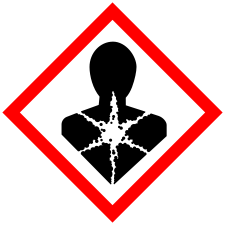10.2 Finding and Interpreting Information about Hazards
Hazard Communication
Remember: hazards are intrinsic, meaning they are fundamental characteristics of substances or activities. They are therefore not easy to reduce. Hazard Communication (“Haz Comm”) can reduce risk in all situations where there is potential exposure to hazardous materials.
Hazard communication (“Haz Comm”) includes both interpreting and sharing information about hazards with others. There are regulatory laws that guide Haz Comm in the workplace. These laws have come from the collective experiences of many experts, and they guide us all toward good work practices. One form of Haz Comm closely connected to work with chemicals is Safety Data Sheets (SDS), formerly known as Material Safety Data Sheets (MSDS). Chemical labels used to describe samples of hazardous chemicals on storage shelves or in the laboratory are also frequently encountered by chemists and chemistry students.
What is a Safety Data Sheet?

Safety Data Sheets are available for commercially-available chemicals from suppliers of those substances. Their appearance may vary somewhat depending on the source, but they always contain:
The name, formula, physical and chemical properties of the material
The author/owner of the information on the document
Information for safe handling and storage of the material
Appropriate responses to emergencies involving the material
Toxicological properties of the material
This information is consistently found on SDS because the Occupational Safety and Health Administration (OSHA) operates based on federal laws requiring these documents, in order to protect the public. Federal OSHA maintains a specific list of information that must be included on SDS at this location:
https://www.osha.gov/Publications/HazComm_QuickCard_SafetyData.html
Pictograms
Any SDS you look at probably includes one or more pictograms communicating the type of hazard(s) associated with the material. Pictograms are supposed to be intuitively understandable. The pictograms convey the following messages about a material:









These pictograms indicate substances are:
Corrosive
Pressurized gas
Harmful
Explosive
Flammable
Oxidizer
Health hazard
Toxic
Toxic to environment
These pictograms are part of an international system for hazard communication called the Globally Harmonized System (GHS). Not long ago there was no such system, and various countries around the world had their own ways to communicate hazard. The GHS has made it possible for people around the world to communicate hazard with one another regardless of the language they use.
Hazard Statements
Hazard Statements are short statements that describe the hazards of a material a bit more specifically than the pictograms. They serve as useful guidance for making decisions about how to work with a hazardous substance. Find these statements on the SDS you have, and use them to determine which of the practices below would be potentially problematic for your chemical:
| Practice | Safe? Or possibly problematic? |
| Storing the material in a glass bottle with a steel screw cap | |
| Transferring the material from one container to another without eye protection | |
| Portioning out small samples from a large stock in a small, confined room | |
| Adding the substance to water | |
| Heating a sample of the substance over an open flame |
Hazard statements can guide someone who is working with a substance, or who has an accident while working with a substance. Imagine how they could help if:
…a small sample of this material was spilled and ended up dropping from the lab bench onto your foot
…you used some of this material and had 50 mL/50 g of excess (waste) to dispose of at the end of your work day?
…you needed to find safe storage for this material for an extended period of time?

